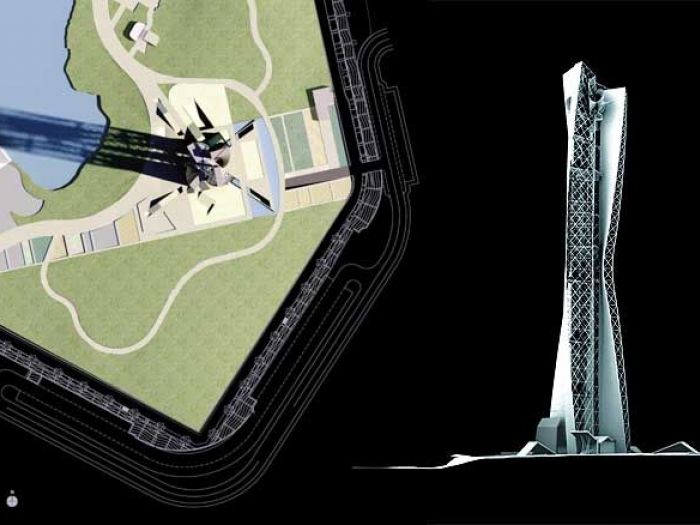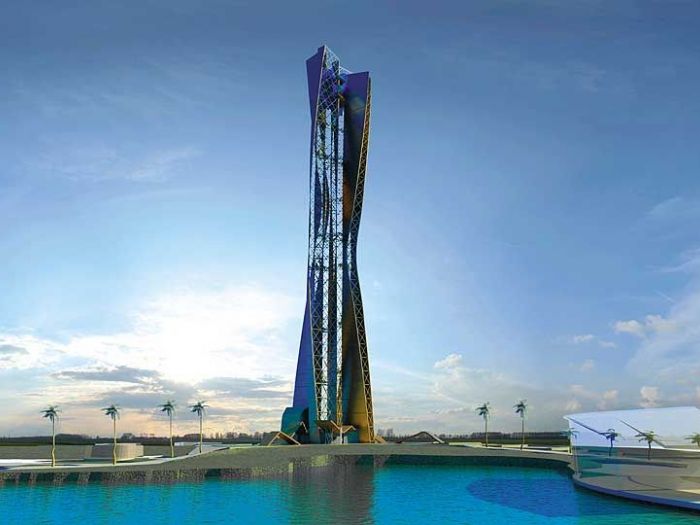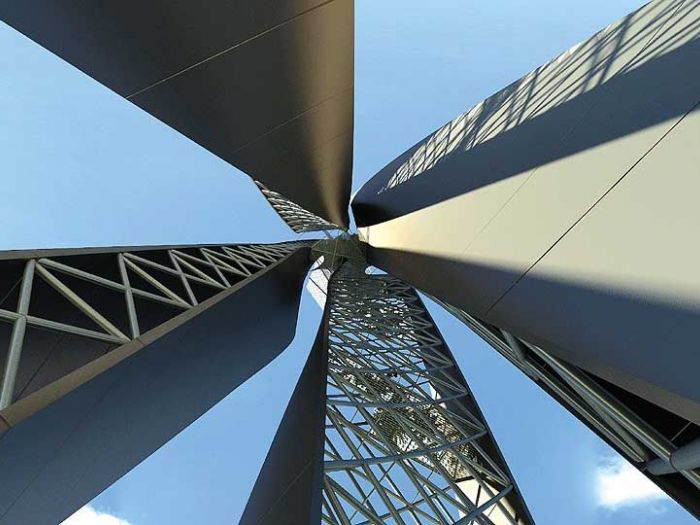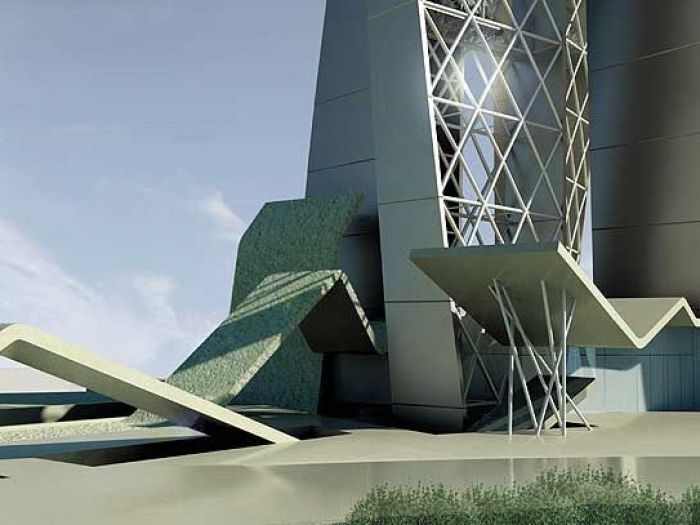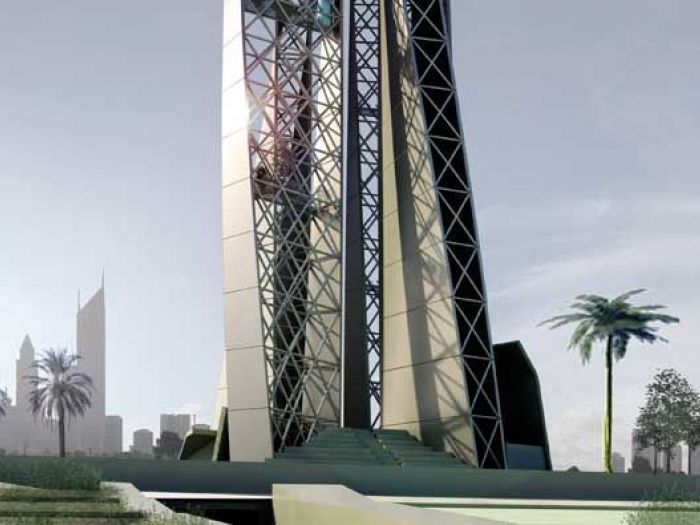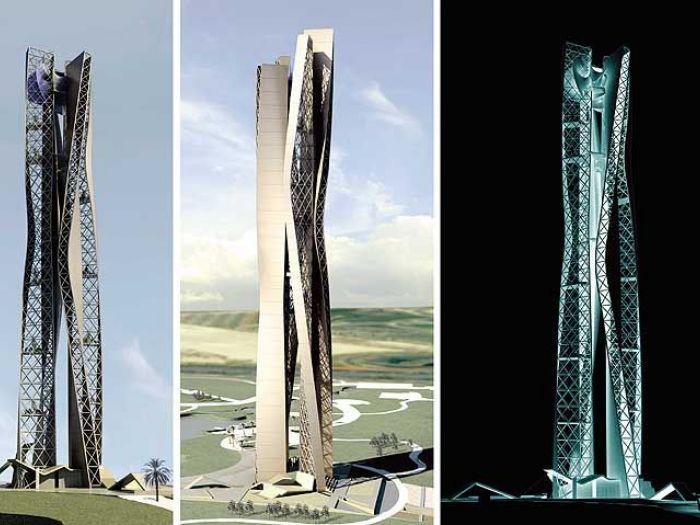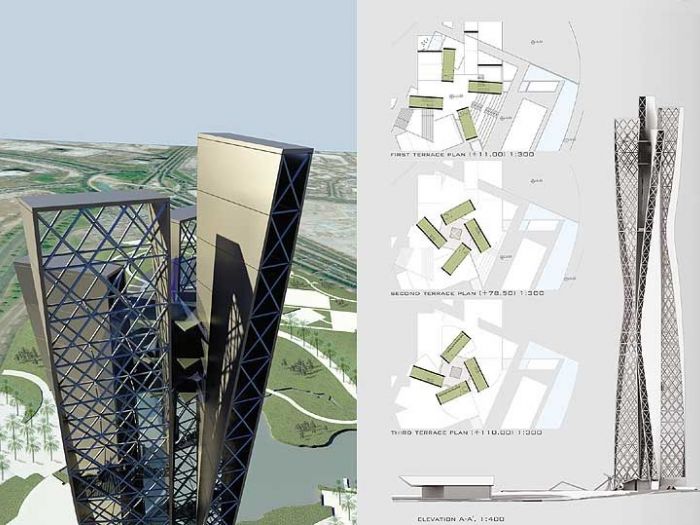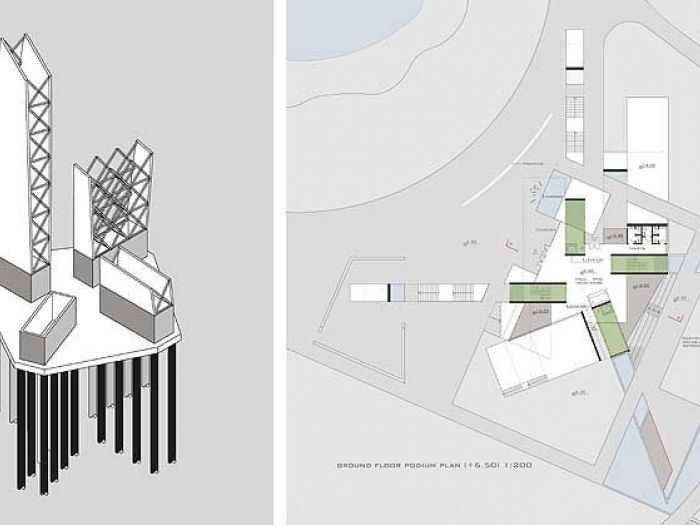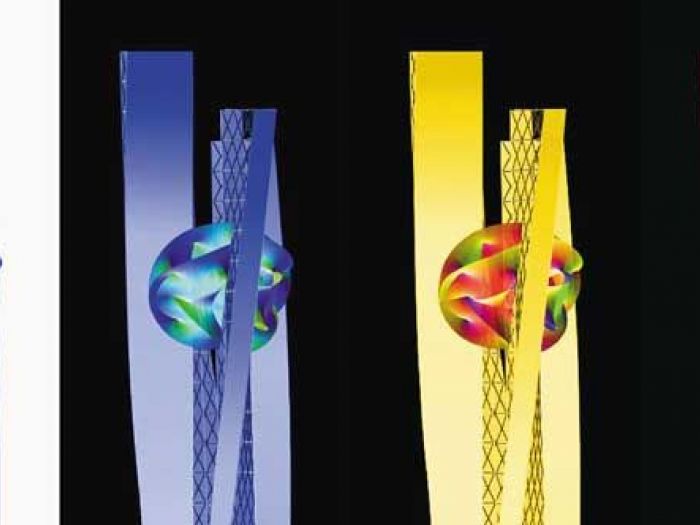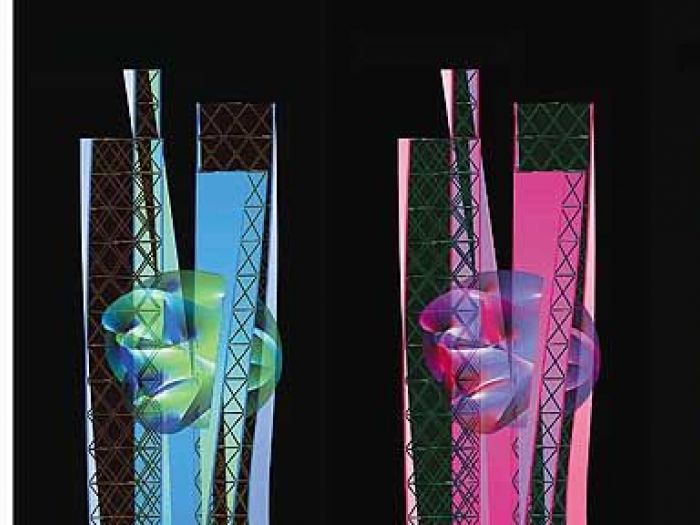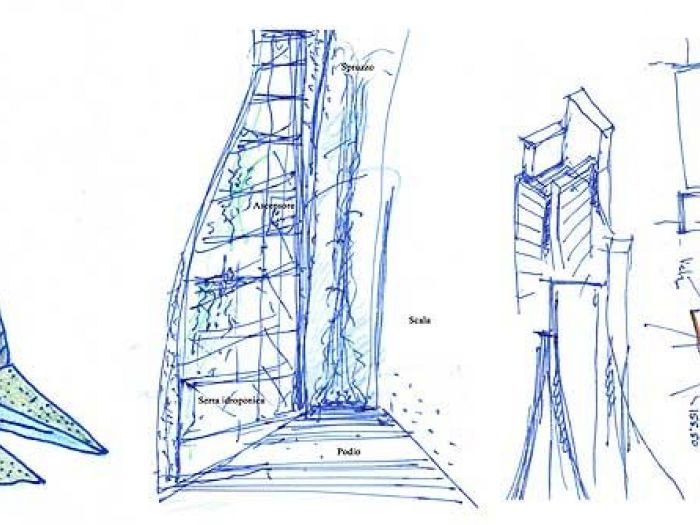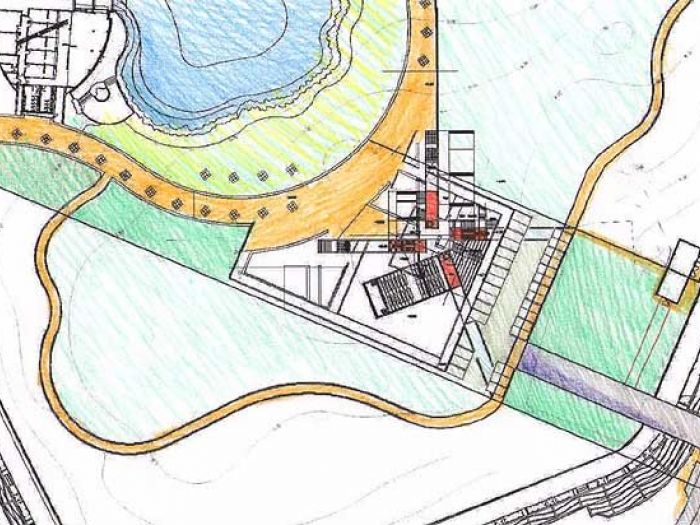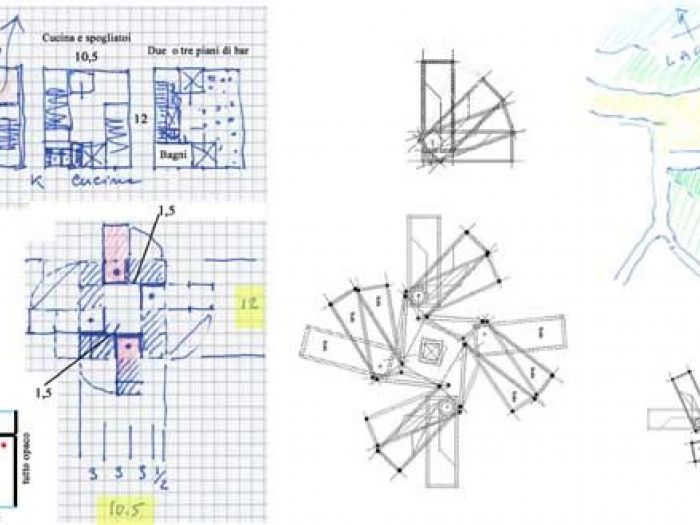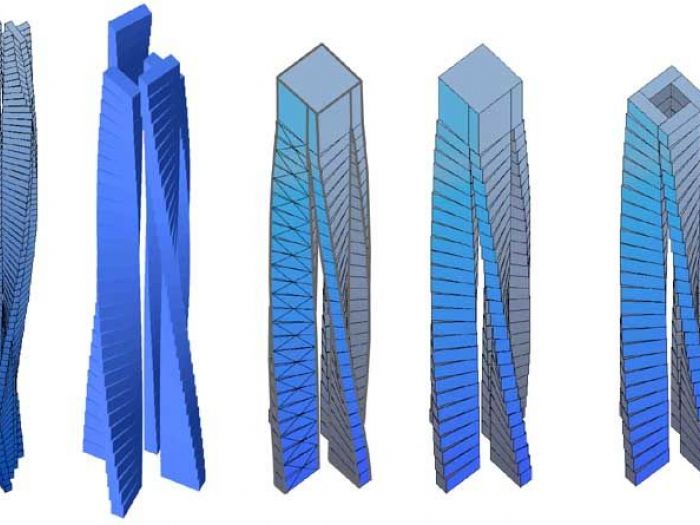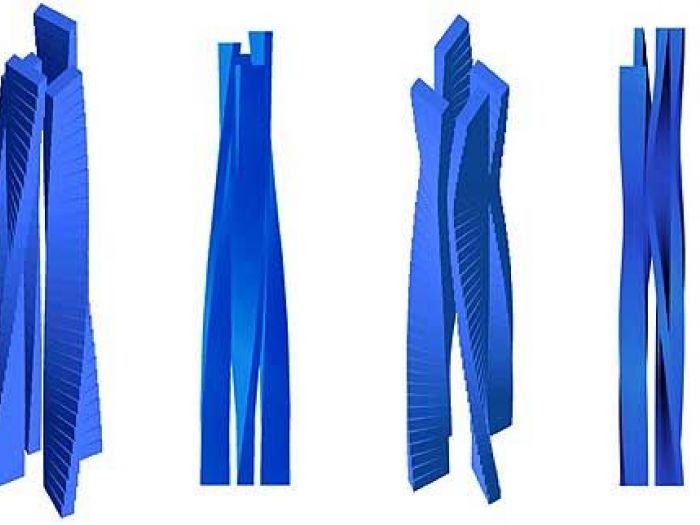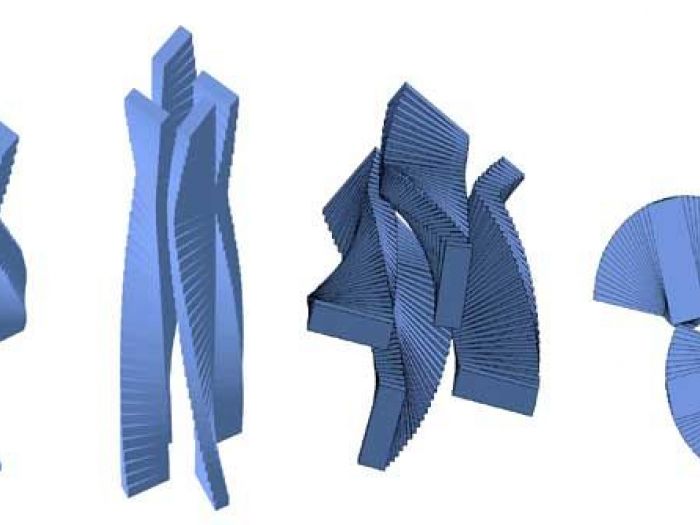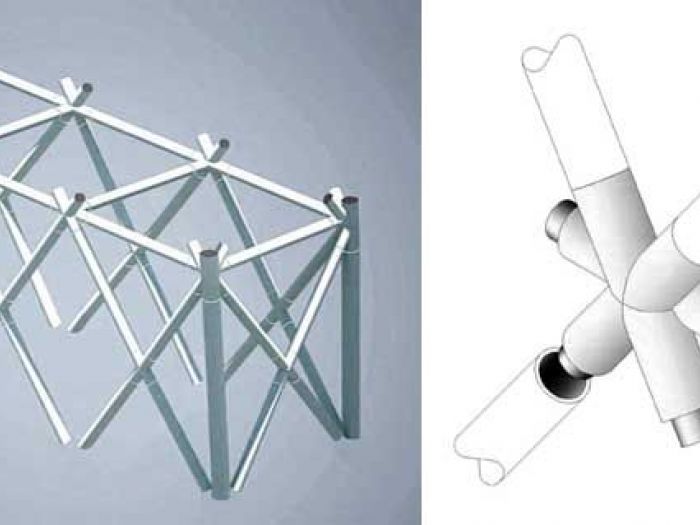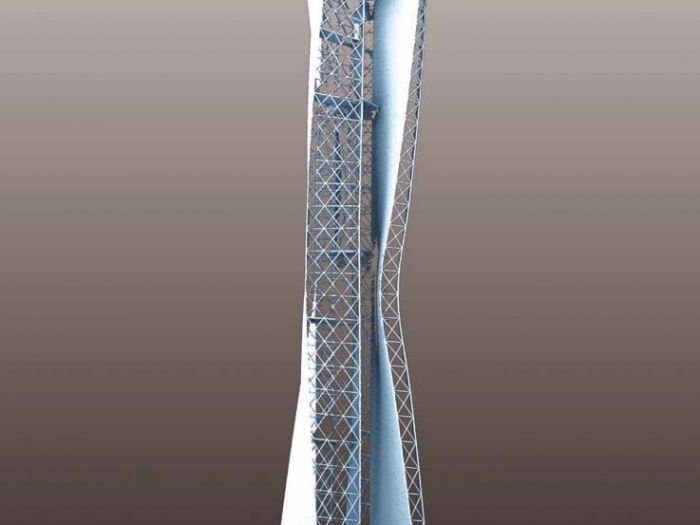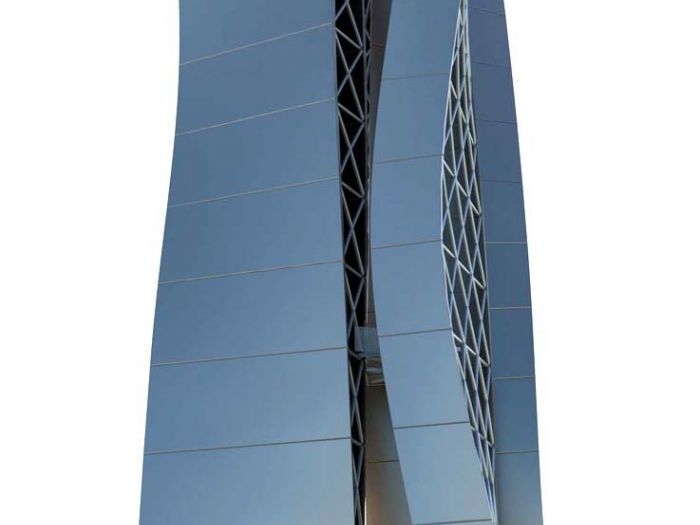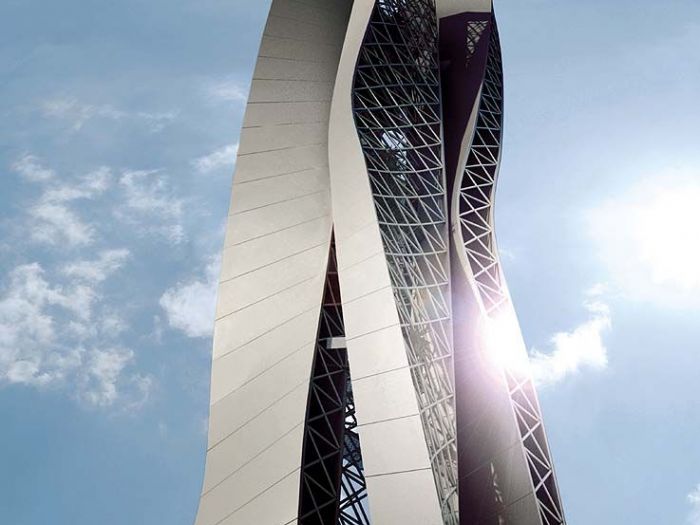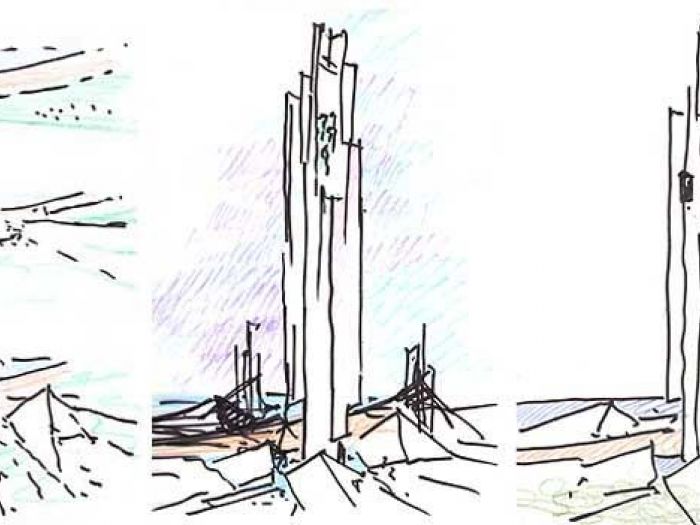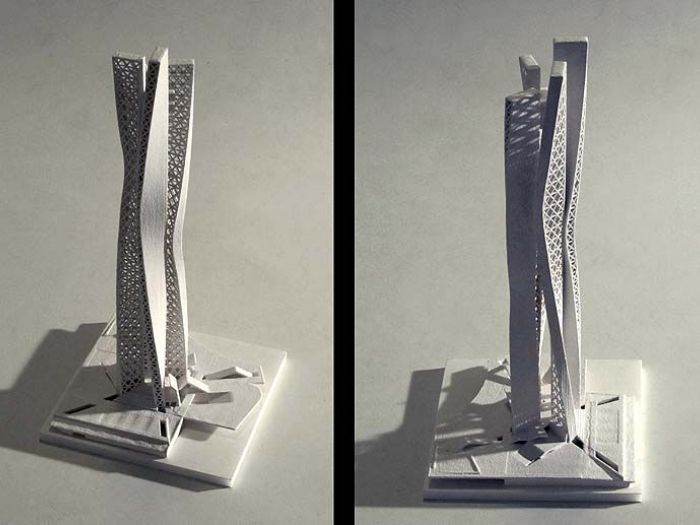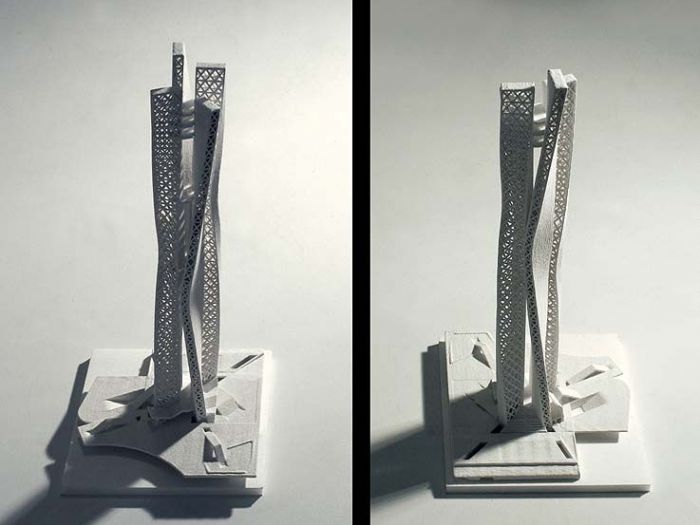Ruggero Lenci
Concorso internazionale thyssenkrupp per una torre simbolo a dubai - Roma (RM)
La presente proposta consiste in un una torre-emblema di 162 metri di altezza ubicata nel za’abeel park di dubai. La nuova “string tower” è accessibile dal sistema di vialetti esistenti che circonda il laghetto e che la collegano all’ingresso principale al parco. Inoltre la torre è accessibile da un parcheggio interrato per 30 posti auto, servito da un nuovo accesso carrabile. Il posizionamento della torre-emblema è stabilito dalle curve di livello e segue l’idea di ubicarla nella parte più alta del sito. Inoltre il punto prescelto è sufficientemente distanziato dagli altri edifici esistenti da consentirne la corretta edificazione e cantierabilità. L’altezza della torre risponde alle limitazioni imposte dalle normative di rispetto del corridoio aereo dell’aeroporto internazionale di dubai. Morfologicamente la sua geometria deriva sia da quella della doppia elica del dna, sia dalla teoria delle stringhe. Essa si compone di quattro “stringhe” che subiscono una rotazione e una contro rotazione. Ognuna di esse è generata in pianta da rettangoli di 3,60x10,50 m. Due delle quattro “stringhe” (opposte tra loro) contengono le scale, le altre due gli ascensori e dei giardini idroponici a sviluppo verticale. Le quattro “stringhe” sono generate da prismi, i “mattoni” della composizione, di 3,60 m di profondità, 10,50 m di lunghezza e 4,50 m di altezza, ognuno strutturalmente definito da tubi orizzontali in acciaio posti ogni 4,50 m in altezza e tubi inclinati di controventamento (che generano tre “x” nel verso della larghezza di 10,50 m, e una “x” in quello dello spessore di 3,60 m). Questo prisma non è perpendicolare ma disassato verticalmente, con una rotazione di 3,75 gradi del piano orizzontale superiore rispetto a quello inferiore, con il centro di rotazione ubicato sul centro geometrico del vano ascensore. In tal modo i due ascensori percorrono una traiettoria perfettamente verticale. Inoltre, i quattro centri di rotazione sono posizionati sui vertici di un quadrato di 8,50 m di lato. Impilati verticalmente l’uno sull’altro, i “mattoni” generano le quattro “stringhe” della torre. La geometria dei “mattoni” è identica nel 70% dei casi. Essa diverge in prossimità dei quattro flessi che nelle quattro “stringhe” hanno luogo ad altezze diverse, tutte in prossimità dei 100 m dal suolo. Tale leggera differenza geometrica del “mattone”, ottenuta riducendone gradatamente la rotazione imposta ai piani orizzontali, nasce dall’esigenza di generare il flesso in modo morbido, e ciò coinvolge i quattro “mattoni” più prossimi al flesso (4 sopra e 4 sotto). Tutti i “mattoni” ubicati al di sopra del flesso sono identici ai sottostanti, ma montati in modo contrario rispetto ad essi.
Thyssenkrupp elevator architecture award
“string” emblem structure in za’abeel park, dubai
The present proposal consists in a tall and unique landmark located in the za’abeel park of dubai on the highest part of the competition site. The new “string tower” is accessible by the existing pedestrian alley surrounding the pond, which connects it to the main pedestrian access to the park. Moreover the tower is accessible by the underground parking for 30 cars which is linked to a new service road.
The position of the tall emblem structure is established by the contours, following the idea of locating it on the highest spot of the given area. Moreover, the selected spot is well distanced by the existing buildings.
The height of the landmark is 162m measured from the existing alley, in that point located at 6,50m above sea level, for a total height of 168,50m above sea level. Its height complies with the limitations of the dubai international airport aviation corridor, being contained within 170m above sea level.
Conceptual principles
The proposed “string tower” provides positive symbolic meanings to the new face of dubai through a vertical design concept which develops, modifies and opens in space.
Its “evolutionary design” wants to be:
A synthesis of architecture and nature;
A synthesis of sculpture and structure;
A synthesis of fashion and technology;
A synthesis of design and biology;
A synthesis of dna and the string theory.
Morphologically, its geometry springs from the dna as well as from the string theory.
If all we know dna and what the nucleotide sequence of the double helix is, not the same can be said for the more recent string theory, both strongly represented in the present design.
String theory is a developing branch of theoretical physics that combines quantum mechanics and general relativity into a quantum theory of gravity. It is of interest to many physicists because of the mathematical consistency involved and because of the large number of forms that can take. String theory strongly suggests that spacetime has eleven dimensions, as opposed to the usual three space and one time, but the theory can easily describe universes with four observable spacetime dimensions as well. It includes objects more general than strings, called branes. The word brane, derived from "membrane", refers to a variety of interrelated objects, such as d-branes, black p-branes and neveu-schwarz 5-branes. These are typically extended objects that source differential form generalizations of the vector potential electromagnetic field. All such objects are known to be related to one-another by a variety of dualities. For example, the black hole-like black p-branes are identified with d-branes, upon which strings end, through gauge-gravity duality. Research on this equivalence has led to new insights on quantum chromodynamics, the fundamental theory of the strong nuclear force.
String theory is a theory in which the electrons and quarks inside an atom are not 0-dimensional objects, but 1-dimensional strings. These strings can move and vibrate, giving the observed particles their flavor, charge, mass and spin. The strings make closed loops unless they encounter surfaces, called d-branes, where they can open up into one dimensional lines. The endpoints of the string can't break off the d-brane, but they can slide around on it.
String theory is a theory of gravity, an extension of general relativity, and the classical interpretation of the strings and branes is that they are quantum mechanical vibrating extended charged black holes. All string theories predict the existence of degrees of freedom which are usually described as extra dimensions. Without fermions, bosonic strings can vibrate in a flat but unstable 26-dimensional space time. In a superstring theory with fermions, the weak-coupling (no-interaction) limit describes a flat stable 10-dimensional space time. Interacting superstring theories are best thought of as configurations of an 11 dimensional supergravity theory called m-theory where one or more of the dimensions are curled up so that the line-extended charged black holes become long and light. Long light strings can vibrate at different resonant frequencies, and each resonant frequency describes a different type of particle. The only way in which strings can interact is by splitting and combining in a smooth way. It is impossible to introduce arbitrary extra matter, like point particles which interact with strings by collisions, because the particles can fall into the black hole, so holography demands that it must show up as a mode of oscillation.
A closed string looks like a small loop, so its worldsheet will look like a pipe or, more generally, a riemannian surface (a two-dimensional oriented manifold) with no boundaries (i.e. No edge). An open string looks like a short line, so its worldsheet will look like a strip or, more generally, a riemann surface with a boundary.
Strings can split and connect. This is reflected by the form of their worldsheet, more accurately, by its topology. For example, if a closed string splits, its worldsheet will look like a single pipe splitting (or connected) to two pipes (often referred to as a pair of pants — see drawing at right). If a closed string splits and its two parts later reconnect, its worldsheet will look like a single pipe splitting to two and then reconnecting, which also looks like a torus connected to two pipes (one representing the ingoing string, and the other — the outgoing one). An open string doing the same thing will have its worldsheet looking like a ring connected to two strips.
An intriguing feature of string theory is that it involves the prediction of extra dimensions. The number of dimensions is not fixed by any consistency criterion, but flat spacetime solutions do exist in the so-called "critical dimension".
Design description
The tall emblem structure is made of four twisted “strings” each one generated in plan by rectangles of 3.60x10.50m. Two of the four strings (opposed one to the other) contain stairs, the other two contain elevators and hydroponic vertical gardens. The strings are generated by prisms, which are the “bricks” of the composition, of 3.60m (depth) x 10.50m (length) x 4.50m (height), each one structurally defined by steel horizontal beams (every 4.50m in height) and diagonal braces (three “x” on the 10.50m in length, generating a net of “xs”, and one on the 3.60m in width).
Design genesis of the thyssenkrupp “string” emblem structure
This prism, the “brick”, is not perpendicular but twisted vertically, with a rotation of 3.75 degrees on the horizontal plane every 4.50m in height, with the centre of rotation located on the elevator shaft. The four centers of rotation are positioned on the vertex of a square of 8.50m.
Piled vertically one another, the “bricks” generate the four twisted “strings” of the tower. The “brick” geometry and structure is, close to 70% of the times, identical. It diverges only in proximity of the four flexes which occur in the four strings at four different heights, all close to 100m above sea level. This slight difference in the “brick” configuration is looked for to generate strings which are twisted smoothly. In fact, close to the flex the degree of rotation of the “bricks” slowly decreases (four “bricks” below and four above the flex).
At ground floor the plan position of the four strings generate an informal cross (a non symmetrical one). The four strings touch ground in this position because one of the main objective of the present design is to generate a dynamic volumetric configuration. Moreover, since the rotation of the “bricks” is constant (in order to make most of them to be equal for optimization in construction) only if the strings touch ground in a non symmetrical cross configuration the flexes can occur at different heights.
While twisting, the peripherycal ends of the strings get closer to the centre of the tower. This twisting “motion” generates, in proximity of the flexes, a slimmer and more compact volume. Once the flexes are surpassed, the four strings gradually invert the verse of twisting. In this way the overall volume configuration - well “planted” on earth designing the above described informal cross – reaches the sky in a positive opening motion.
The centre of rotation of the “bricks” that generates each single string is located, as said before, on the geometrical centre of the elevator shaft (this occurs also in the two strings containing the stairs). In this way the elevators can move up and down on a straight vertical direction, not being influenced by the twisting of the string that contains it. (even if it is possible to build an elevator that moves up and down along a non straight line, one that moves on a straight one gives much more warranties during time, especially in environmental conditions full of sun and sand.)
The two long sides of the twisted strings containing stairs are closed with panels. Instead, the twisted strings containing the elevators and the hydroponic gardens are closed with panels on the two short sides. All the sides showing the structure are opened to the air.
Each “brick” will house a temporary vertical tube located on the centre of rotation. This in order to control the exactness during the mounting progress of all the parts of the twisted strings. This temporary tube contained in each “brick”, will generate four very tall and perfectly straight vertical lines of tubes, which will be removed once the tower is up. In addition, to better control the overall geometry, these pipes can be temporary connected together one to the others with steel bars generating squares 8.50m wide.
To synthesize, the design principles are:
The structure of the tower directly supports, at the same time, the stairs and the elevators.
The reason why the elevator shafts have been selected as the centre of rotation of the twisted strings is to allow elevators to move on a straight direction: the four strings twist around the geometrical centre of the elevator’s shafts.
Rising and descending in glazed elevators moving straight inside a twisted “string” will transmit the passengers a special sense of dynamism.
The reason why the centers of rotation of the twisted strings are positioned on the vertex of a square is to base a complex geometrical design on a simple figure, so to allow maximum precision and constant possibility of “double checking” during construction.
The twisted strings are structurally connected one to the other at three different elevations above ground: at 78.50m., at 110m., at 137-141.5m., the last one being the two levels of the cafeteria. The two previous levels are also intermediate stations. Here it is possible to exit from the elevators on a floor slab made in steel and glass, with beams connecting and bracing one to the other the four twisted strings. From these intermediate stations it is possible to visit the vertical hydroponic gardens contained inside the twisted strings of the elevators. Light flight of stairs are contained in the two hydroponic gardens, for maintenance and security egress from the elevators in case of break-down.
The “brick” of the entire system is composed of two elements: tubes and “x” shaped connectors with a seat to house the tubes. They can be mounted in the following two different ways — at discretion of the construction company — or in a combination of both:
1. The “brick” (3,60x10.50x4.50) can be assembled at ground floor, then raised with the crane and installed in place.
2. The “brick” can be assembled directly in place by mounting each tube to its “x” shaped connector.
The same concept is valid for the flights and the landings of the stairs: they can be directly contained inside the “brick”, or can be installed in place.
Hydroponic vertical gardens
Hydroponics (from greek: hydro water, ponos labor) is a method of growing plants using mineral nutrient solutions, without soil. Terrestrial plants may be grown with their roots in the mineral nutrient solution absorbing essential mineral nutrients as inorganic ions in water. In natural conditions, soil acts as a mineral nutrient reservoir but the soil itself is not essential to plant growth. When the mineral nutrients in the soil dissolve in water, plant roots are able to absorb them.
In the proposed hydroponics vertical garden the required mineral nutrients are introduced into a plant's water supply.
Almost any terrestrial plant will grow with hydroponics, allowing the possibility to make a wide range of experimentation in time. According with the present proposal, the new “ecological tower” in dubai could be an emblem of “sustainability” of the third millennium, a “blurring architecture” housing everlasting natural experimentations.
A café of 150 sq.m on two levels containing a service area and restrooms is located at 137 and 141.50m above sea level, its roof slab at 146m becoming a panoramic platform. This panoramic volume is surrounded by stainless steel brise-soleils describing multiple “orbits” around it, which are configured following a figuration deriving from the “string theory”.
The tower sits on a two storey podium for cultural and conference facilities of 800 sq.m. It includes tickets kiosk, a small bookshop, a local children’s library, toilets and a conference space for a total of 100 persons that can be divided into three conference rooms.
The roof of the podium, shaped as a pyramid and with several cuts and skylights bringing natural light below, is also accessible by the visitors. It includes an outdoor amphitheatre and a surface in front of it to install a temporary stage, located on the roof slab of the underground parking for 30 cars. The parking, as well as a deposit and a mechanical room, are accessible from the new service road.
The existing landscape and the pedestrian paths of the competition site are preserved and incorporated in the proposed design, without requiring demolitions of any kind. Rock gardens are proposed and some water is included as fountains and reflective pools.
Vedi gli altri progetti
ARCHISIO
Invia una richiesta di lavoro a Ruggero Lenci
Trova i migliori Architetti a
Roma| Milano| Napoli| Torino| Palermo| Genova| Bologna| Firenze| Bari| Catania| Venezia| Verona| Messina| Padova| Trieste| Taranto| Brescia| Parma| Prato| Modena| Perugia| Ravenna| Livorno| Cagliari
Vedi tutti
Trova altri professionisti a Roma
Architetti| Imprese Edili| Imprese di Impianti Elettrici ed Elettricisti| Imprese di Traslochi| Imprese di Ponteggi| Imprese di Costruzioni Ecologiche| Ingegneri Edili| Imprese di Tende da Interni| Imprese di Bonifica Eternit| Rivenditori di Arredo Giardino ed Esterni| Rivenditori di Camini e Stufe| Rivenditori di Cucine| Geometri| Rivenditori di Illuminazione| Rivenditori di Arredamento| Rivenditori di Pavimenti e Rivestimenti| Fotografi di Interni| Rivenditori di Piscine| Designer di Interni| Artisti| Imprese di Tinteggiature| Parquettisti| Marmisti| Imprese di Impianti di Climatizzazione
Vedi tutti
Architetti vicino a te

